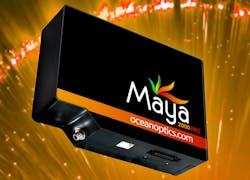Spectrometer from Ocean Optics features three trigger operating modes
The Maya2000 Pro back-thinned CCD miniature spectrometer features triggering functions to provide accurate timing and synchronization between the spectrometer and other devices. New features include one normal and three trigger operating modes, support for RS-232 communications, improved optoelectronics for dynamic range to 15,000:1, trigger jitter to 100 ns, and dark noise reduction to 6 RMS counts.
Ocean Optics
Dunedin, FL
www.oceanoptics.com
-----
PRESS RELEASE
Ocean Optics Adds New Triggering and Interface Options for Maya2000 Pro Spectrometer
High-sensitivity spectrometer ideal for low light level, UV-sensitive applications
Dunedin, FL (October 27, 2011) – Ocean Optics (www.OceanOptics.com), has added triggering functions to its Maya2000 Pro back-thinned CCD miniature spectrometer to provide accurate timing and synchronization between the spectrometer and other devices. Three low-jitter trigger and normal operating modes are now possible. Applications include pulsing a light source to occur when acquiring a spectra and synchronizing spectral acquisition to coordinate with samples moving through a process stream or sensors reaching a certain temperature level.
In addition to triggering, Ocean Optics has enhanced Maya2000 Pro performance with support for RS-232 communications and improved optoelectronics that increase dynamic range (to 15000:1), lower trigger jitter (to 100 ns) and decrease dark noise (to 6 RMS counts).
Triggering provides precise timing between devices. The Maya2000 Pro can be triggered so that sending the spectrometer a pulse causes it to do something such as turn off or on a light, activate a pulse in a pulsed light source or start or end spectral acquisition in the spectrometer. For example, in the External Triggering mode, an event outside the sampling system (such as a button push, lever activation or laser) electronically pulses the spectrometer’s trigger pin and starts acquisition of the spectra with microsecond accuracy.
The Maya2000 Pro has a 30-pin connector and 10 user-programmable digital I/Os. Its enhanced onboard programmable high-speed FPGA controller enables triggering and provides other performance advantages. Available operating modes are Normal (spectrometer continuously acquires spectra) and the three trigger modes:
External Hardware Level Trigger. The spectrometer waits for a sharp rise in voltage on the trigger input pin, and then acquires spectra until the voltage is removed.
External Synchronous Trigger. Spectrometer acquires data from an external trigger event (such as a push button) until the next time the trigger is activated, at which time the spectrometer ceases spectral acquisition and begins a new acquisition. Integration time cannot be set, and is the effective period between triggers.
External Hardware Edge Trigger. The spectrometer waits for a sharp rise in voltage on the trigger input pin, and then acquires one spectrum. One spectrum will be acquired for each trigger unless an acquisition is already in progress.
The Maya2000 Pro is a back-thinned 2D FFT-CCD spectrometer with high sensitivity, 75% peak quantum efficiency and excellent UV response. Maya2000 Series spectrometers are ideal for low light-level applications such as fluorescence, DNA sequencing and measurement of certain biological samples. The spectrometer can be used in the VUV (to ~150 nm) with the addition of a nitrogen purgebox to help lessen the absorption of water and oxygen in the VUV.
To learn more about Maya2000 Pro triggering, visit www.oceanoptics.com, call Ocean Optics World Headquarters at +1 727-733-2447, or e-mail [email protected].
-----
Subscribe now to Laser Focus World magazine; it's free!
